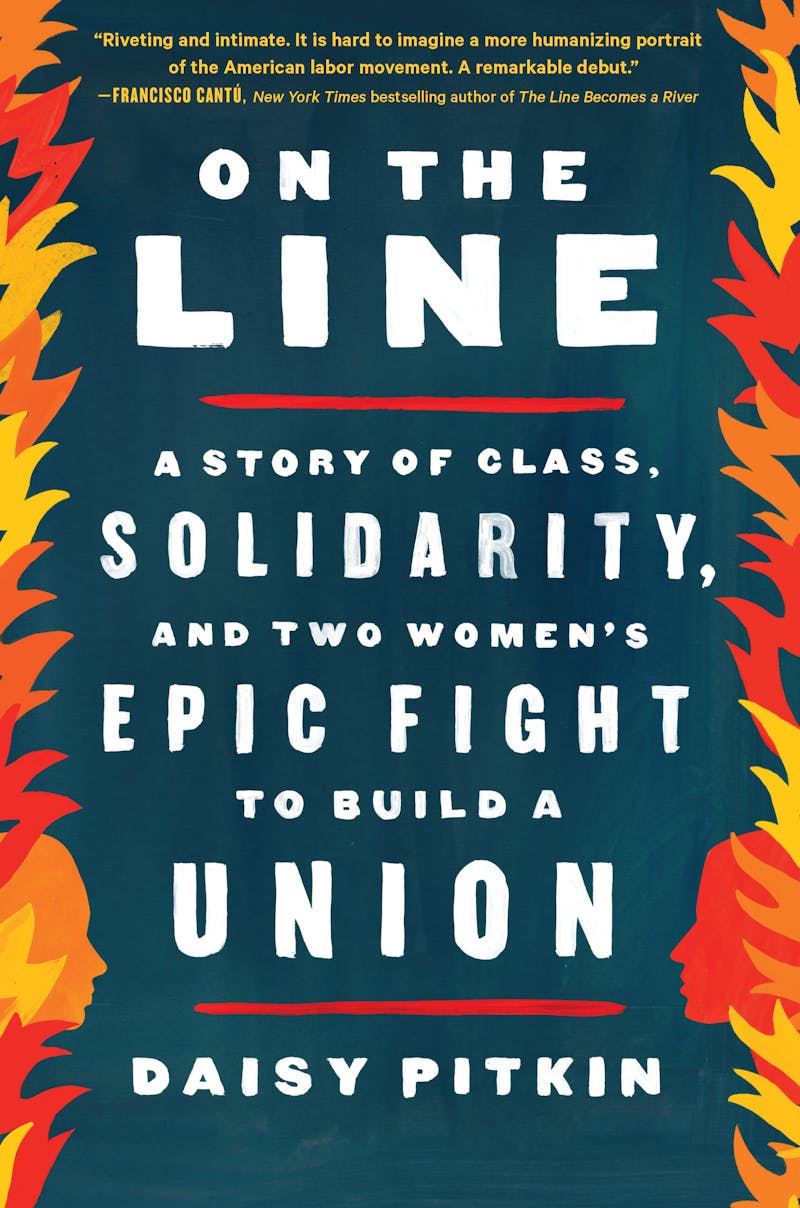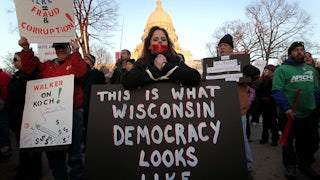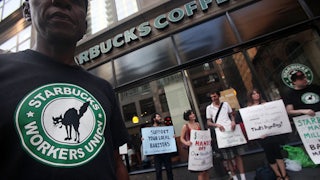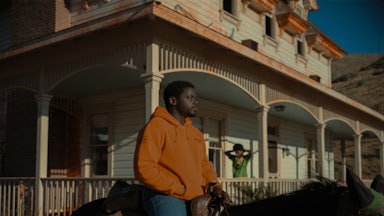My first job out of college was as a cashier selling snacks and magazines at a Chicago airport. My coworkers and I—about two hundred of us, mostly African Americans and Filipino immigrants—made long commutes from all over the city, earning less than nine dollars an hour and constant disrespect from our bosses. Our general manager, a man I’ll call Richard, was known for scrutinizing workers’ uniforms as we punched in to find minor infractions, or sneaking up on us at the register to catch us texting when no customers were around, then writing us up. Our jobs were miserable, and he made them more miserable.
So like millions of other workers before us, we began to organize a union—talking endlessly to coworkers on our breaks and the train ride home, mapping out with staff organizers who was a leader on which shift and which of their coworkers they could convince to vote for the union, figuring out how to overcome divisions between workers across barriers of race and personality, crafting an effective pitch for Filipino workers to make in Tagalog to coworkers on the fence, and a million more tiny details that all had to line up to win the vote. I took the job with the intention of helping organize a union but wasn’t prepared for the pushback that Richard spearheaded. The day we announced the union drive, union supporters on the early shift wore union buttons to work. Management took the buttons as declarations of war, and Richard sent all the union supporters home. The call quickly went out from organizers to union supporters: management had attacked us. We had to strike back.

Richard sent so many of us home that the company no longer had enough workers to run the stores, so he left the main office deep in the bowels of the airport to do our jobs in the terminals himself. Near the security checkpoint, we rehearsed how we would confront him. My conflict-avoidant heart raced. Growing giddy, we passed through security and roved the airport, racing around the never-ending stream of travelers to look for him. We eventually tracked him down at a store in Terminal 3, ringing up customers for four-dollar bottles of water. Richard, visibly sweating, refused to speak with us. “As you can see,” he said, fussing with a display case of Chicago-themed tchotchke key chains, “I’m very busy here.”
We were forging ahead, shouting our demands, when Richard—this man who had inflicted so many petty indignities upon so many of us, had made us feel so small in exchange wages just above the least he could get away with paying us—suddenly halted his pretense of working and took off at a near sprint down the terminal, abandoning the store with no one at the register. We watched him run, astonished.
“Whatcha runnin’ from?” one of my second-shift coworkers called after him down the terminal, cackling. Just a day earlier, he had terrorized us, his subordinates. Now, he couldn’t even look us in the eyes—he was afraid of us. I’ve done a lot in my life since that day, but never have I felt as exhilarated and as shocked at my own sense of power as I did among a whooping group of cashiers and stockers, watching our boss shrivel in the face of the collective power we had built together.
My experience wasn’t out of the ordinary. Every time workers grow fed up with their jobs and start talking to coworkers about forming a union to change it, such scenes of human drama play out—often with not just paychecks but life and limb at stake in the face of strikebreakers and police. The labor movement isn’t just the best means for workers to win better wages and benefits and end their managers’ on-the-job dictatorship; it’s also a generator of genuine heroism in average people. Every union fight is a David-versus-Goliath battle—the epic stuff of Biblical narratives, of Greek myths, of Hollywood blockbusters.
There’s a rich history of labor documentary and feature filmmaking in America, as well as excellent labor journalistic and historical writing, and fictionalized labor organizing narratives pop up occasionally in film and TV. Yet few twenty-first century labor fights ever receive mainstream narrativization (and those that do can see their politics watered down). In the labor movement’s recent decades of decline, few tales from the frontlines of the class war have turned into character-driven, compulsively readable books or watchable movies. Daisy Pitkin’s On the Line: A Story of Class, Solidarity, and Two Women’s Epic Fight to Build a Union is an exception. A working union organizer in the trenches for nearly two decades, in her memoir she depicts what organizing a union actually looks like: the newfound capacity for heroism and solidarity among workers and the boundless rapacity and cruelty of bosses, the steadfast dedication and stupidity of labor leadership, and the grueling personal toll of throwing one’s life into organizing only to be rewarded with half-victories or outright defeat. Few writers have captured the triumph and tragedy of organizing a union in America in prose as intimate or compelling.
Pitkin tells the story of a five-year union organizing campaign, begun in 2003, at an industrial laundry owned by Sodexho in Phoenix, Arizona, where wages were low and working conditions were brutal, unsafe, and unsanitary. Workers sorted and washed bags of linens from major institutions like hospitals, working at breakneck pace while operating massive, dangerous industrial laundry machines. “Sometimes there are syringes and scalpels, sometimes body parts, wrapped in the linens,” a worker named Alma tells Pitkin. Safety gear is absent or insufficient, and “there is a lot of blood and puke and feces.” Alma’s coworkers have stories of limbs crushed while working the machines.
Pitkin begins as a rookie organizer, new to the Union of Needletrades, Industrial, and Textile Employees (UNITE), a scrappy union launching an organizing drive among low-wage, immigrant, many undocumented, mostly women workers in a red state. “We both laughed a little,” she writes of her initial job interview with an organizing director, “and shook our heads at how fucking hard it would be, how much of a war.”
War it was. The campaign starts in secret, with organizers pulling trash bags out of the laundry’s dumpsters to search for workers’ contact information. They make contact with workers in the middle of the night after shift changes and organize a secret union committee, which then carries out a stealth campaign to convince a super majority to sign union cards. After painstaking organizing, workers call for a union election. As they so often do, management immediately goes scorched earth, intimidating workers and targeting key union supporters. When workers walk off the job in response to health and safety concerns, Alma is fired in retaliation, then hired by the union to continue the fight. She grows close to Pitkin, and the book is written in a series of second-person letters to her.
At every step, Alma and her coworkers, alongside Pitkin and the other organizers, face constant attacks from the boss. Their task is to figure out how to keep the group of low-wage immigrant workers bound together in a sense of solidarity that is strong enough to withstand those attacks, despite the obscenely pro-management bias of US labor law—“a situation in which the level of unfairness and volatility is often so extreme it is difficult to capture through language,” Pitkin writes. Plant management’s abuses were, in fact, so numerous and so egregious that Human Rights Watch would release a 2010 report on them.
Throughout, Pitkin weaves in labor history, telling the story of the mostly female, immigrant workers that made up UNITE’s predecessor union a century earlier—and of the 146 who burned or jumped to their deaths in the Triangle Shirtwaist Factory fire in 1911, and the bosses who faced almost no repercussions for the incident of mass worker death. That history isn’t ancient for the workers, who know of another Arizona laundry where a manager tried to block an exit and force workers to continue working during a fire. For Pitkin, the history serves “as a reminder of the urgency and high stakes of organizing, of what can happen if we lose.”
The campaign confronts a new set of difficulties when Pitkin and her team learn of a merger between her union, UNITE, and another, the Hotel Employees and Restaurant Employees (HERE), to create UNITE HERE. As labor’s membership roles have dwindled in recent decades, such mergers have become common survival strategies. Like many others, this merger was executed from the top, with little input from workers or lower-level staff.
Problems immediately become evident once HERE arrives in Phoenix. The unions’ two cultures differ wildly—principally, from Pitkin’s perspective, around HERE staff’s cultlike fealty to their leadership and personally intrusive organizing tactic called “pink-sheeting,” in which organizers obtain intimate personal information from both workers and other organizers, then use that information to lean hard on workers and organizers to carry out the union’s organizing program. In 2009, Steven Greenhouse reported on these tactics in the New York Times, with one worker telling him, “I quit the union because I felt this was psychological abuse.” Pitkin calls them “a minefield of manipulation.”
Soon, the two sides are waging pitched battles that are every bit as rancorous as their fight with the boss. Pitkin’s new HERE supervisor orders her to submit to the pink-sheeting; she refuses. They put Alma in the “hot seat,” subjecting her to a group interrogation searching for intimate life details; she sobs. Meanwhile, the laundry’s management takes advantage of the chaos in the union and ratchets up their counter-offensive. The HERE staff seem unbothered.
One night, the battle between the two sides reaches a breaking point: HERE tries to storm the union office. Pitkin stands inside behind a barricaded door; the strain of both the doomed union merger and the unceasing attacks from the boss seem to have culminated in her seeing Alma through the glass, taking orders from a HERE organizer.
Pitkin’s narrative is not a tidy narrative of the noble workers defeating their ignoble bosses. As is often in the case in American unions, labor’s internal dysfunction becomes a major stumbling block on the way to action. The campaign’s brutal demands wreck her personal life. Workers get fired and and betray each other. The law helps no one but the boss. Union organizers nearly come to blows. And even when workers eke out a victory in the form of a contract, it’s so desiccated that Pitkin seems to view it more like a defeat.
On the Line is not a tale of simple optimism in service of class struggle. Pitkin, her fellow organizers, and the workers like Alma throw everything they possibly can at Sodexho, but Sodexho has the money and the power and the freedom to squash much of those efforts. In many ways, Pitkin’s story isn’t particularly unique. The boss’s brutality goes beyond that seen in a typical union drive, but only in degree, not in kind.
But Pitkin’s book features innumerable scenes of both the wrenching traumas and the unparalleled triumphs and wide-ranging personal transformations that union organizing entails. Even before they have won union recognition, for example, the plant’s female workers use their newfound power to organize to support their coworkers facing instances of domestic violence. Alma organizes a brigade of workers to leap into action when a coworker has been hit. When one calls, “three women showed up at her house with baseball bats” just after the abuser boyfriend flees.
The workers hadn’t yet won their union. “But on the way back to your house that night,” she writes to Alma, “you were wired, your eyes burnished with the adrenaline of the missed confrontation. You said, ‘The company can do what they want with their recognition. We already have our union.’”
Later, when the union and the company are duking it out in court, Alma testifies. After days of witnessing management’s lawyers bully workers, a court interpreter (Alma speaks no English) mistranslates a key phrase of her testimony. Pitkin, who speaks Spanish, hits a breaking point: “That is not what she said,” Pitkin yells in the middle of the court proceedings. The judge immediately orders her removed. Alma is unsure of what is transpiring because of the language barrier, but Pitkin writes, “You started chanting into the witness microphone: ‘Union, union, union’ in your best American-accented English. You were still chanting as the courtroom door closed behind me.”
Nearly every page of On the Line features staggeringly dramatic scenes like this. It’s these scenes, featuring some of society’s most exploited and oppressed members, that make the reader realize why a person as talented and driven as Pitkin would continue banging her head against the wall to try to organize unions. Even in a country as hostile to workers’ rights to organize as the United States, while fighting under labor’s banner, she has witnessed innumerable miracles.
We’re currently in the midst of a fledgling but significant uptick in worker organizing and militancy throughout the United States. At the time of writing this piece, almost 200 Starbucks stores have unionized, in the face of vicious union-busting. (Pitkin currently works as an organizer on the campaign.) Amazon, one of the most powerful companies in history, suffered an astonishing defeat on Staten Island at the hands of an unlikely group of workplace militants. Just a few years ago, a teachers strike wave swept Trump country and shut down public school systems across multiple states.
All of these struggles have not just wrested power and money from corporations’ and governments’ hands. The workers who carried them out have summoned courage never summoned before; they’ve risked their livelihoods for the possibility of more dignified lives; they’ve stared down tyrannical managers and insisted they’re not scared. They have defied the message that working-class people hear every day in this country: that they should take their meager, stagnant wages and continual on-the-job assaults on their sense of self-respect and be grateful.
Pitkin’s book captures the drama and transformative power of labor organizing better than any book published in the United States in years. With so many powerful narratives generated by similar union campaigns in American history—so many Richards chased down airport terminals, so many Almas metamorphosing into fearless fighters—we should have many more books like hers.






